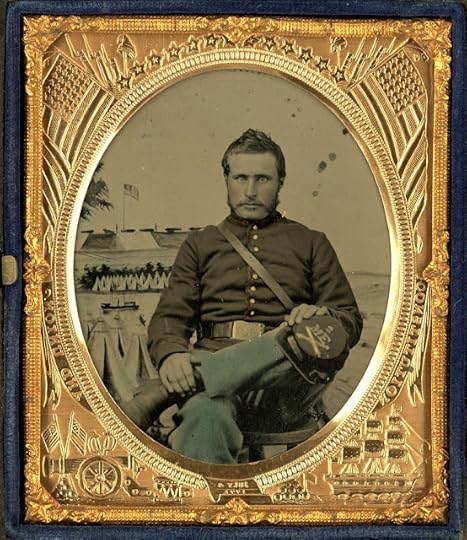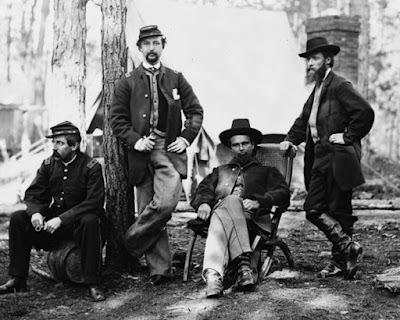Fighting for the Honor of the Old Pine Tree State: The 4th Maine Battery at Cedar Mountain
Rolling into combat for the first time on the afternoon ofAugust 9, 1862, at Cedar Mountain, First Lieutenant Lucius Haynes of the 4thMaine Battery noted how the wounding of one of the men inspired the men of thebattery in the fight.
“We had notfired but three shots before Abel Davis of New Portland fell, wounded in theleg,” he wrote. “But this did not intimidate, it rather incited our boys torenewed valor. Now the firing of the enemy becomes indeed terrific; a perfectstorm of shell and solid shot pours in upon us from the front and right, comingapparently from six different Rebel batteries. We replied with spirit andundoubted effect. Every man stood bravely at his post- the officers workinghand-to-hand with the men, taking the places of those who had so nobly fallenat the posts. We had never been under fire before, but I think it can be saidof our Maine artillery not the first time under fire, that it did honor to thedear old Pine Tree State.”
LieutenantHaynes’ letter first saw publication in the August 29, 1862, edition of the KennebecJournal published in Augusta, Maine. It is worth noting that the 4th Maine Battery was equipped with 3-inch Rodman rifles at Cedar Mountain, having been issued these guns in late May 1862 and was under the command of Captain O'Neil W. Robinson.
 This image depicts an artillerist in the 2nd Maine Battery who also fought at Cedar Mountain but a little later in the engagement than the 4th Maine. Note the hat brass that calls out the battery number (2), ME for Maine, and crossed cannons symbolizing the artillery branch.
This image depicts an artillerist in the 2nd Maine Battery who also fought at Cedar Mountain but a little later in the engagement than the 4th Maine. Note the hat brass that calls out the battery number (2), ME for Maine, and crossed cannons symbolizing the artillery branch. Culpeper Courthouse, Virginia
August 14, 1862
Now that theexcitement and confusion of the late battle of Slaughter Mountain has somewhatsubsided, I will endeavor to give you a detailed description of its horrors andevents.
Prince’sbrigade, to which we were attached, was ordered to move from their camp onSaturday morning last at 11 o’clock. After a rapid march of about five milesduring which we were almost suffocated by heat and dust, we were halted in agrowth of woods about a quarter mile in width. Hardly had we recovered from thefatigue of our rapid movement, when the order came again ‘Forward!’ Emerging fromthe woods, we saw at once that we were really to engage the enemy. Already theshells were flying over our heads. The infantry moved off and took up theirposition on the left of the line of battle, which, consisting of our entirecorps (about 7,000 men) extended nearly a mile from east to west directly infront of Slaughter Mountain.
“Upon our arrival at the woods, General Prince placed CaptainRobinson under arrest for some reason, the exact nature of which was neverclearly understood but was generally supposed to be running by other troops andgetting out of place in the line. There was not a very good feeling existingbetween the General and Captain Robinson as was shown by a little incident thatoccurred that morning. After first harnessing up, the captain sent a lieutenantto the general asking for orders. The general very curtly replied, ‘When I haveorders for Captain Robinson, I will send them.’ This reply did not put thecaptain in the best of humor and perhaps had an effect on him during theremainder of the day. After about half an hour in the woods, the captain wasrelieved from arrest.” ~ History of the 4th Maine Battery LightArtillery
In front ofour line and about 30 rods in advance was a slight elevation. Here our battery,the 4th Maine, was ordered to take position and commence firing. Wewent into battle under a fire already becoming severe. But our boys were ascool as veterans. We were soon at work. We had not fired but three shots beforeAbel Davis of New Portland fell, wounded in the leg. But this did notintimidate, it rather incited our boys to renewed valor. Now the firing of theenemy becomes indeed terrific; a perfect storm of shell and solid shot pours inupon us from the front and right, coming apparently from six different Rebelbatteries. We replied with spirit and undoubted effect. Every man stood bravelyat his post- the officers working hand-to-hand with the men, taking the placesof those who had so nobly fallen at the posts. We had never been under firebefore, but I think it can be said of our Maine artillery not the first timeunder fire, that it did honor to the dear old Pine Tree State.
 Captain O'Neil W. Robinson of the 4th Maine Battery sits in the chair with two of his fellow battery commanders of the 3rd Corps artillery brigade in this image taken at Brandy Station, Virginia. Artist Alfred Waud of Harper's Weekly stands at right. At Cedar Mountain, Captain Robinson found himself temporarily under arrest by his brigade commander General Henry Prince; Prince himself would be captured during the battle by a private in the 23rd Virginia.
Captain O'Neil W. Robinson of the 4th Maine Battery sits in the chair with two of his fellow battery commanders of the 3rd Corps artillery brigade in this image taken at Brandy Station, Virginia. Artist Alfred Waud of Harper's Weekly stands at right. At Cedar Mountain, Captain Robinson found himself temporarily under arrest by his brigade commander General Henry Prince; Prince himself would be captured during the battle by a private in the 23rd Virginia. Thus, wefought for two hours, aided by two batteries on our right and the 6thMaine on our left. Occupying the center of the artillery line as we did, wenecessarily received the most direct and fearful fire of the enemy. At onetime, in the short space of half an hour, one man was killed, three horsesshot, and both pieces in the right section struck, one of the pieces beingentirely disabled by a shot, which, striking its wrought iron axle three inchessquares, broke it near the wheel. [Ed. note- this was Lieutenant Haynes' section]
“Lieutenant Haynes section on the right seemed to get thebrunt of the fire and after getting about 50 rounds from each gun, a shellstruck the wheel of Sergeant Bangs’ piece and glancing struck Byron Phillips,tearing away part of his chin and shoulder. He was taken to the rear where hedied about two hours later. A little later, Sergeant Owen’s piece was struck bya shell and the axle broken so that it could not be used again. The splinters slightlywounded several of the gunners and the concussion of a shell as it struck andexploded very near Ambrose Vittum’s head caused a deafness in one ear fromwhich he has never recovered.” ~ History of the 4th Maine BatteryLight Artillery
At 5 o’clock,the infantry came to our rescue and amid incessant cheering, charged upon theenemy. The volleys of musketry, the booming of cannon, the cheers of the men,the clouds of smoke, and the whizzing of the shell through the air, with themingled groans of the wounded and dying, gave a tone of infernal horror to ascene which I hope never to witness again.
The battlelasted until nearly 8 o’clock. When we retired from the field, almostexhausted, the moon was shining brightly, lighting up this field of carnagewith unearthly splendor. As we passed through the woods again to encamp underarms for the night, we found that heavy reinforcements from Sigel and McDowellhad arrived and we felt comparatively safe. But it was not until the next day(the Sabbath) that we secured any peaceful rest. Then indeed it was refreshingto lie down upon the ground and easing our tired limbs, thank God for His kinddeliverance from the jaws of death.
 This detail from the American Battlefield Trust's map of the Battle of Cedar Mountain shows the Federal artillery arrayed along the Mitchell's Station Road, the 4th Maine Battery being the battery just to the right of "Banks" on the map. According to Lieutenant Haynes, the 6th Maine Battery occupied the position to the 4th Maine's left.
This detail from the American Battlefield Trust's map of the Battle of Cedar Mountain shows the Federal artillery arrayed along the Mitchell's Station Road, the 4th Maine Battery being the battery just to the right of "Banks" on the map. According to Lieutenant Haynes, the 6th Maine Battery occupied the position to the 4th Maine's left. Our loss inkilled and wounded already amounts to about 1,000; it will not much, if any,exceed that amount. General Prince of Maine is taken prisoner but is unhurt. Inour battery we had one man killed and six slightly wounded. If our ranks hadbeen full, we must have lost many more. Ten of our horses were either killed ordisabled by solid shot or pieces of shell.
It is statedin some of the dailies that the 2nd and 5th MaineBatteries were in the fight and did great execution; this is a mistake. Theywere not on the field at all. The 5th Maine did not fire a singleround while the 2nd Maine fired a few rounds of ammunition after 9 o’clockupon a battery that contrived to annoy our advance until late at night. We donot detract from the honor of others but must claim our own. The 4thand 6th Maine were all the Maine batteries upon the field and theywere there, too, until they were ordered to leave. This was done in good orderwith the Rebel infantry within 30 rods of their rear sections.
The battleitself was a draw game. But the results flowing from it are replete withsuccess to our army. Jackson commenced a retreat the next day and is now beyondthe Rapidan with General Pope close on his heels. So much for the first fight;I will write again.
Lucius M.S. Haynes was a young pastor at the Baptist Church of Augusta, Maine when he joined the 4th Maine Battery in late 1861.
Sources:
Letter from First Lieutenant Lucius M.S. Haynes, 4thMaine Battery Light Artillery, Kennebec Journal (Maine), August 29, 1862, pg. 2
History of the 4th Maine Battery Light Artillery in the Civil War, 1861-1865. Augusta: Burleigh & Flynt, 1905
Daniel A. Masters's Blog
- Daniel A. Masters's profile
- 1 follower



